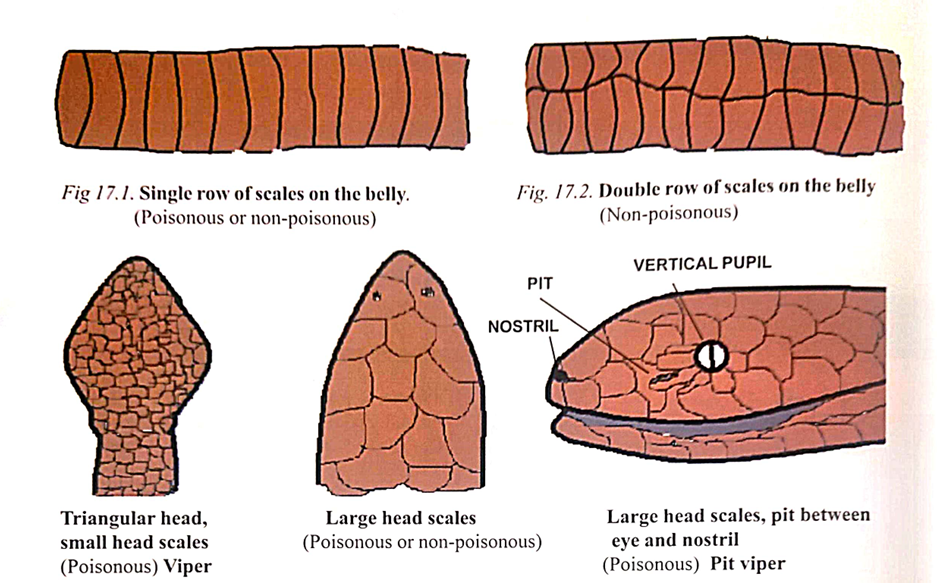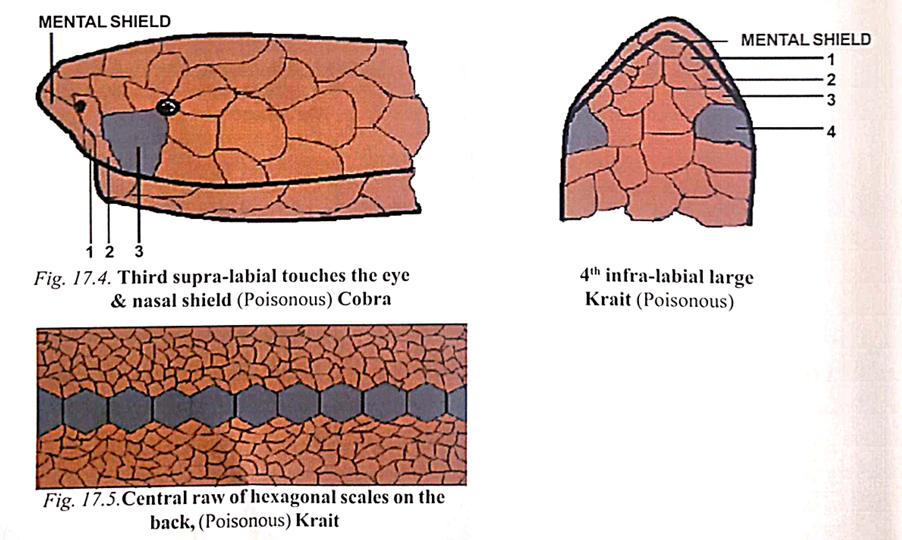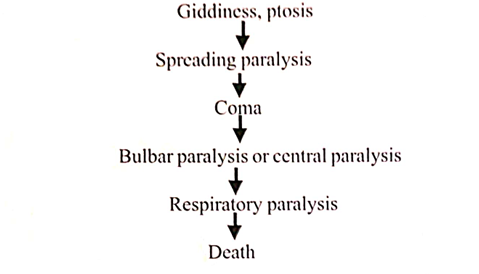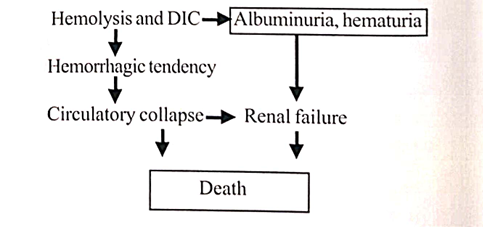17.Animal irritants
Ophitoxemia
Poisoning by snake bite is referred to as ophitoxemia.
Snakes are among the most feared creatures in the animal kingdom, yet many religions venerate them.
Overview of Snakes
Approximately 2000 species of snakes exist worldwide, with less than 10% being poisonous.
In India, a significant number of poisonous snakes are identified.
Common Poisonous Snakes in India
Elapidae
Common Cobra (Naja naja)
King Cobra
Common Krait (Bungarus caeruleus)
Banded Krait
Coral Snakes
Viperidae
Russell's Viper
Saw-Scaled Viper
Pit Vipers
Hydrophidae
Sea Snakes
Snake Bite Statistics
Annual snake bites may reach up to 5 million, with 2.8 million resulting in poisoning.
Fatalities from snake bites can range from 1.2 to 1.4 lakh deaths annually worldwide.
In India, approximately 45,000 snakebite fatalities are estimated each year, though accurate records are lacking.
Identifying Poisonous vs. Non-Poisonous Snakes
Trait | Poisonous Snakes | Non-Poisonous Snakes |
|---|---|---|
Head Shape | Triangular (e.g., Viper) | Usually not triangular |
Head Scales Size | 1.Small (viper) 2.Large and a. if there is a pit in between eye and nostrils: Pit viper b. if third supra-labial scale is large and touches the eye and the nasal shield: Cobra. c. no pit is seen and the 4th infralabial is largest: Krait | Large |
Belly Scales | Large and cover the entire breadth | Small or moderate and do not cover the entire breadth |
Fangs | Present | Small and short teeth only |
Tail | Flat or short and tapering | Not so |
Scales Distal to the Anal Plate | Divided or not divided | Divided |
Habitat | Nocturnal habits | Not so |
Specific Examples | Vipers, Cobras, Krait | Others |
Identification of Poisonous Snakes
General Guidelines
Belly Scales:
Divided scales indicate non-poisonous snakes.
Single scales may indicate poisonous or non-poisonous.
Head Characteristics
Triangular Head:
Covered with small scales may indicate poisonous (viper).
Look for a pit between the eye and nostrils (pit viper).
An arrow mark or bird foot mark on the head center indicates poisonous (saw-scaled viper).
Large Head Scales:
May indicate poisonous or non-poisonous.
Check the 3rd supra labial:
If touching the eye and nasal shield, it is poisonous (cobra or coral snake).
If not touching, check the ventral aspect of the head.
Infra Labial:
If the 4th infra labial is larger than others, it is poisonous (krait).
Uniform Body Color:
Black head with uniform body color (without dots) indicates poisonous (coral snake).


Cobra
Common Cobra (Naja naja)
Characterized by a hood and a spectacle or monocle mark on the dorsal side.
Sometimes has 3 bands on the underside of the mark.
White band at the separation between the hood and body.
Length: 1.5 to 2 metres.
Belly scales: single up to genital pore and double thereafter.
Poisonous fangs on the upper jaw, grooved, followed by one or two small teeth.
Predominantly neurotoxic, slightly hemotoxic.
Head Structure:
Large scales on head
3rd Supra-labial Shield:
Larger and touching the eye and nasal shield.
Pupils are circular.
King Cobra (Opheophagus hannah)
Hood present, but lacks a spectacle or monocle mark.
Length: Typically 3 to 4 meters.
Yellow, brown, or black, often with yellow or white cross bands.
Habitat: Forest areas of the Himalayas, Bengal, Assam, Western Ghats; rarely in human habitats.
Belly scales are undivided; caudal scales are divided.
Venom: Predominantly neurotoxic with slight cardiotoxic effects; fangs are grooved.
Vipers
Three main categories:
Russell's viper
Saw-scaled viper
Pit viper
Russell's Viper (Daboia russelli)
Also known as "kinder" in northern states.
Length: 1 to 1.5 meters.
Characteristic flat triangular head with a distinct 'V' mark.
Back features three rows of diamond-shaped brown or dark brown marks with black rings; outer rows have white edges.
Belly has broad undivided scales; caudal scales divided into two rows.
Small scales on the head; makes a hissing sound when disturbed.
Fangs are canalized; pupils are vertical.
Reproduction: Viviparous, giving birth to 20 to 25 young at a time.
Saw-scaled Viper (Echis carinatus)
Length: Usually 40 to 80 cm.
Body covered with highly keeled, dry, and pointed scales that create a rustling sound.
Color: Brown, dark brown, or mixed with yellow.
Back has a wavy white line on both sides with brown spots in between.
Triangular head with arrow or bird's foot mark.
Has small scales on the head.
Abdomen: Broad single row of scales.
Tail Shields: Not divided.
Pit Vipers (Family: Crotalinae)
Identification: A noticeable pit located between the nostril and the eye, allows them to sense temperature difference, environment, objects moving nearby.
Belly scales not divided
Short tails with divided ventral scales.
Types of Pit Vipers in India:
Bamboo Pit Viper (Trimeresurus gramineus)
Habitat: Forest areas of the Western Ghats.
Physical Traits: Triangular head, greenish color, length around 60-100 cm.
Malabar Pit Viper (Trimeresurus malabaricus)
Color Variations: Brown, green, yellow, or red.
Habitat: Found in green forests of the Western Ghats, particularly near streams.
Local Name (Kerala): Paramandali or cholamandali.
Length: 30 to 80 cm.
Hump Nosed Pit Viper (Hypnale hypnale)
Known for its hump-nosed triangular head shape.
May have dark spots on either side of the back.
Length: 40 to 80 cm.
Hemotoxic Properties: All vipers, including the hump-nosed pit viper, are predominantly hemotoxic.
Krait
Common Krait
Scientific Name: Bangarus caeruleus
Local Names: Known as 'karayat' in the northern states and 'vellikettan' in Kerala.
Length: 1 to 1.5 meters.
Coloration: Steel blue or black with single/double white bands on the back and a creamy-white belly.
Physical Features:
Head covered with large scales.
4 infra-labial shields (the 4th one is the largest).
Central row of large hexagonal scales on the back.
Banded Krait
Scientific Name: Bangarus fasciatus
Length: Usually 2 meters.
Description: Blunt tail end; predominantly black with wide yellow or white bands.
Physical Features:
Black mark on the neck that extends to the eyes.
4 infra-labials (4th one is largest).
Caudal and belly shields are not divided.
Geographical Range: Commonly found in the north-eastern regions.
Coral Snakes (Colliophis)
Description:
Slightly venomous snakes, rarely bite
Brown body with a black head
Typically found in forest areas of South India
Average length: approximately 0.5 meters
Anatomy:
Caudal scales are usually divided
The 3rd supralabial scale touches the eye and the nasal shield
Venom:
Neurotoxic venom
Species Examples:
Slender coral snake (Colliophis melanurus)
Striped coral snake (Colliophis nigrescens)
Bibron’s coral snake
Sea Snakes (Hydrophidae)
Overview:
70 species of sea snakes worldwide, 22 species documented in the Indian Ocean
All sea snakes are poisonous
Characteristics:
Small eyes and prominent nostrils on top of the head
Paddle-shaped flat tails
Coloration: black, bluish-black, or yellowish, with or without bands
Beaked sea snake (Enhydrina schistosa)
Most common variety in Kerala coast (called 'valakadian kadal pambu')
Rarely bites but highly venomous; myotoxic and neurotoxic
Other common species include annulated sea snake, bar bellied sea snake, and yellow sea snake
Sea snakes are all poisonous.
Their venom is both myotoxic (affecting muscles) and neurotoxic (affecting the nervous system).
Fangs and Venom
Fangs: Two curved teeth on the upper jaw connected to the venom gland via a venom duct.
The venom gland is a type of salivary gland in poisonous snakes.
Types of fangs:
Viper: Canalized fangs.
Cobra: Grooved fangs.
Fang replacement takes 4-6 weeks.
When a snake prepares to bite, fangs become erect and point forward.
Bite marks: Two distinct impressions from the fangs.
The distance between the marks indicates the size of the snake's mouth.
Only one mark may be seen if the bite is weak or if a fang is broken.
Constituents of Snake Venom
Color: Pale yellow, amber, or colorless.
Cobra Venom
Predominantly neurotoxic, containing:
Neurotoxin: Polypeptides causing paralysis and affecting cardiac and respiratory centers.
Cardiotoxin: Direct action on the heart.
Cholinesterase: Impairs neuromuscular transmission.
Phospholipase-A: Destroys phospholipids in nervous tissue, aiding neurotoxin penetration.
Hyaluronidase: Facilitates venom spreading by breaking down tissue barriers.
Protease: Enzymatic action.
Histamine: Involved in inflammatory response.
Viper Venom
Predominantly hemotoxic, containing:
Phospholipase-A, B, C, D : Catalyzes the hydrolysis of lipids, causing lysis of red blood cells.
Hyaluronidase
Lecithinase
Acts on endothelial cell lipid layers.
Produces lysolecithin.
Increases fragility and permeability of blood vessel walls, leading to leakage of blood cells and plasma into extracellular space.
Proteases
Cause tissue damage.
Result in anticoagulant effects due to fibrinogen destruction.
Lead to disseminated intravascular coagulation (DIC).
Alter vascular permeability resulting in edema, bruising, blistering, and necrosis at bite sites.
Cytolysin
Proteinase
Histamine: Platelet Lysis
Thromboplastin
5-Hydroxytryptamine (serotonin): Increase vascular permeability; also linked to pain.
Krait Venom
Neurotoxic, similar constituents to cobra venom.
Signs and Symptoms of Snake Bites
Factors Influencing Symptoms:
Site, depth, and number of bites.
Amount of venom injected.
Species and size of the snake.
Individual’s reaction, age, and size.
Site: Extremities most commonly bitten; bites to head, face, or chest are more dangerous.
Severity of Symptoms:
Varies based on snake species and size.
Cobra bite: Primarily neurological symptoms.
Viper bite: Hemorrhagic tendencies and nepatorenal damage.
Sea snakes: Myotoxic effects.
Dry Bites: Minimal or no symptoms if venom is not injected (e.g., biting over clothes).
Individual Reaction: Anxiety and fright can escalate clinical conditions, leading to psychological shock or death.
Faster absorption of the poison with exertion.
Cobra Bite
Initial Reactions (10 minutes post-bite):
Reddish wheal around the bite mark.
Minimal local swelling; tenderness and slight radiating pain present.
Progression:
Numbness due to nerve paralysis begins after 30 minutes.
Symptoms include sleepiness, intoxication-like feeling, weakness, reluctance to move.
Muscle weakness increases, leading to spastic paralysis in lower limbs.
Paralysis may spread to trunk and head.
Possible nausea, vomiting, excessive salivation.
Weakness in extra-ocular muscles, strabismus, ptosis, ataxia, incoordination.
Difficulty in speech and swallowing due to paralysis of the tongue, pharynx, and larynx.
Complete Paralysis: Observed roughly 2 hours after the bite.
Respiration and Heart Rate Changes:
Respiration becomes slower.
Heart rate increases.
Patient remains conscious but cannot speak.
Comatose state leads to eventual respiratory failure and heart stop.

Fatal Dose:
3 drops of cobra venom; 12 mg of dried venom.
Fatal Period:
Death typically occurs 8 to 12 hours after bite.
Severe poisoning may lead to death within half an hour.
Krait Bite
Symptoms resemble cobra bite but with no swelling or pain at the bite site.
Drowsiness and intoxication are intensified.
Mild convulsions occur only in terminal stages.
Fatal Dose: 6 mg of dried venom.
Fatal Period: 4 to 6 hours; severe cases may see death within half an hour.
Viper Bite (Viperine Snake Bite)
Immediate Symptoms:
Severe pain at the bite site within minutes.
Tenderness, redness, and pain in the area surrounding the bite.
Swelling occurs within 15 minutes; blood-stained discharge develops from the wound.
Additional Symptoms:
Nausea, giddiness, vomiting, sweating, dilated pupils, and abdominal pain.
Elevated body temperature.
Tingling and numbness of the tongue, mouth, and scalp.
Localized swelling; possible blood extravasation and blister formation.
Hematological Effects:
Hemolysis, decreased red blood cell count, and platelet count.
Urine may contain blood; sputum may be blood-stained.
Prolonged bleeding time and clotting time.
Disseminated Intravascular Coagulation (DIC) results in bleeding from gums, rectum, and bite site.
Renal Complications:
Signs of renal failure include oliguria, albuminuria, and hematuria.
Symptoms include blurring of vision, headache, dizziness, and weakness.
Terminal Symptoms:
Severe suppuration at the wound site, circulatory collapse, and coma can result.
Violent convulsions may occur just before death.
Cause of Death: Typically due to hemorrhage and shock.
If survival occurs, necrosis and sloughing at the bite site may take months to heal.

Russell's Viper: Fatal dose = 15 mg; Fatal period = 1 to 2 days.
Saw-scaled Viper: Fatal dose = 8 mg.Fatal period = 1 to 2 days.
 Knowt
Knowt